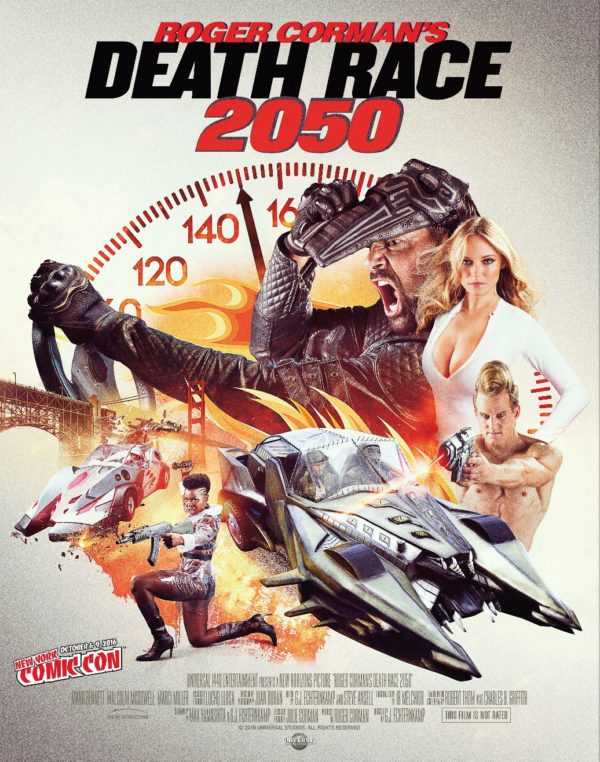Death Race 2050 (2016)
The original Death Race 2000 came about for many of the same reasons as Black Sabbath did: skepticism of the optimism based in technological and political Utopianism around it, a phenomenon that seemed irrefutable but in fact, as human assertions often do, concealed a vast and secret doubt.
Death Race 2000 introduced us to an alternate vision of the future in which democracy and consumerism have merged, producing a single mega-powerful corporation which serves as both consumer magnet and socialist state. To keep the groundlings from rioting, the state stages a number of panem et circenses style spectacles including the Death Race, a cannonball run across America where the goal is for drivers to kill each other and rack up points by murdering unsuspecting citizens with their cars.
Add in a massive dose of grim humor, and you have the groundwork for a satire that is amazingly both insightful and watchable. This in turn may have influenced a generation of anti-positive movies like Idiocracy and Demolition Man, in which the future is portrayed not as Blade Runner styled dystopia but a Utopian project that succeeds and makes its citizens into neutered idiots as a result.
In this way, Death Race 2050 turns back the dial of seriousness established by Death Race (2008) which was more of an adventure/horror film featuring the growling and unshaven Jason Statham. In that film, the power struggle was grim and the focus was more on a struggle for life and death; here, the focus is on satirizing what civilization has become in the hands of good intentions (as in, “the road to Hell is paved with…”).
A decade or so after Idiocracy woke up the world to the consequences of democratic empowerment and the welfare state, Death Race 2050 revisits the original film in a grimmer postmodern version: the world presented is bleaker, a space where most of the population are indeterminately beige and living off Universal Basic Income (UBI) which keeps them in poverty. The few white people are relatively impoverished but consider themselves proud to be middle class. As society winds down, rich multi-racial elites rule the world cynically and citizens flee to whatever sources of meaning — cults, drugs, rebellion — that they think will make the process existentially survivable.
In this brave new Amerika, regions are named after Mark Zuckerberg and cities have become sprawling favelas. The race car drivers, chosen for their membership in ethnic and gender stereotypes common to this future time, are as cynical as the elites, seeing the race as a way to survive better through the destruction of others. In this way, the entirety of USA 2050 resembles William S. Burroughs’ “algebra of need”: people using others as a means to their own power because there is no unity or cooperation, and in its stead, a cynical tyranny has arisen, empowered by a population more concerned with tacos and television than the future.
Race is treated as part of the dysfunction. Most actors are mixed-race or racially ambiguous. Perhaps the most profound moment in the film is when the ghetto-talking African-American driver reveals, in elegant academic English, that her parents were university professors and she acts out a stereotype in public for the profit potential (she is also the author of a contemporary pop hit, “Drive, Drive, Kill, Kill,” which is both catchy and disturbingly simplistic).
Featuring the delightfully pathological Malcolm McDowell as the leader of the Cathedral, this film takes callous indifference to human life to new comedic levels. Corpses pop apart, flinging intestines across the screen; ordinary people who seem dumb as rocks can be counted on to do only what is least productive and most destructive at any time. The country, portrayed as essentially an open-air junkyard, seems in the grips of heat death and conscious only of its next distraction as the darkness slowly — ever so slowly — closes in.
Should we seek a message in Death Race 2050, it can be found in the Huxleyian revelation that most people in fact not only enjoy the race but derive meaning from it of a religious level, much like pre-2016 Americans found in watching sports or politics. It is a distraction from the fact that civilization and life is moribund, so they strap on virtual reality goggles and distract themselves with drugs, celebrities and murder.
This cynical vision of America is not really American so much as it is human. When we confuse what we wish were true with what is real, we create disasters which always end this way: pointless, hopeless and excited only by destruction. Filmed in the type of off-hand and low-budget style as Idiocracy, the grimly humorous Death Race 2050 is a similar warning that its vision is not of the future, but the present.
Tags: death race, death race 2000, death race 2050, idiocracy, movies, roger corman










